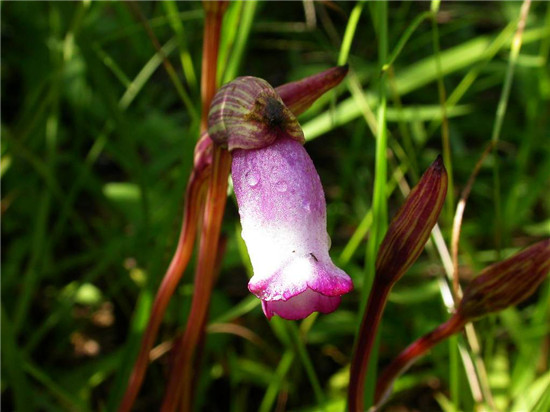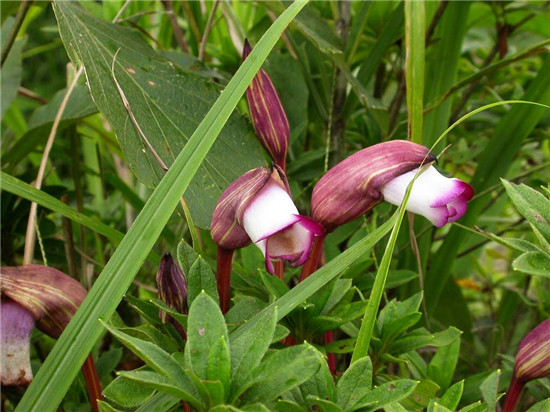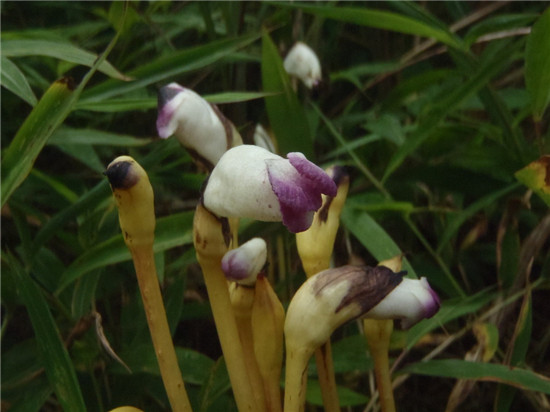Introduction to the plants of Zizania latifolia
Wild Zizania latifolia is an annual parasitic herb, as high as 35 rice. Next, let's take a look at this strange plant.

Wild Zizania latifolia is a strange plant without green leaves, that is, she can not rely on her own photosynthesis to get nutrients, in order to survive, she has to parasitic on other plants, so some people call her "vampire in plants". Plants similar to wild wild rice are called "parasitic plants", while parasitic objects are called "hosts".
Generally speaking, wild Zizania latifolia is parasitic on the roots of sugarcane, mango and thatch plants at low elevations. Wild Zizania latifolia is 15-30 cm tall. Her calyx is fleshy, shaped like a flame bag, and the Corolla is tubular, which is perpendicular to the pedicel and is shaped like a pipe, so it is also known as a "pan pipe", which is easy to identify. Some people call her "golden key", "teaspoon grass" and "taro grass". The florescence is between August and October.

Wild Zizania latifolia is an annual parasitic herb, as high as 35 rice. Stem simple or branched from base, yellowish brown or purplish red, a few scalelike leaves sparsely at stem base. Flowers solitary, purplish red, with long stalks; calyx bract-shaped, one side oblique, 2-3 cm long, lower tip pointed; Corolla tubular, wide and inwardly curved, 2-6 cm long. Ca. 2.5 cm in diam., apical 5-lobed, abduction; stamens 4 and 2 strong; pistil 1, ovary superior, stigma peltate. Capsule ovoid, 1-1.5 cm long. Seeds small, numerous, orbicular, perforated reticulate. The florescence is from September to October.
The parasitic plant Zizania latifolia is an annual parasitic herbaceous plant. The whole family is a parasitic plant, and this species is the most common in the south. Stem base partially branched, unbranched above ground. The leaves degenerated into scales and the whole plant was fleshy. Branch apex flowering, calyx spathelike, crown 2-lipped, purplish red, yellowish white. Underground roots are often attached to parasitic plants of Gramineae. The whole plant is used medicinally, with the effect of clearing away heat, detoxification and detumescence.

Every trip has unexpected surprises, pay close attention to nature, there are elaborate gifts everywhere. Amazed the flowers I had never seen before in a vast expanse of mango grass. In the late autumn dusk in the mountains, Zizania latifolia looks particularly shy and charming, drooping its head and hiding in the bushes, seemingly afraid of reckless humans, finding her traces and trampling on her elegant demeanor.
An old woman walking along with two dogs passed by, amazed at the treasure she had never seen before, ecstatically admiring the beauty of nature and regretting her neglect of the beautiful world. She couldn't help being seduced by wild wild rice. Leaning on crutches, she bent down and picked up the thin flowers.

In my eyes, I couldn't help getting cold, and I couldn't help blaming myself in my heart for telling the selfish old woman that she had never thought of her own kindness, but she got the funeral of the flowers. Perhaps the old woman who walks through here every day is indifferent to nature, which is the greatest kindness to sentient beings.
This is the whole content of the introduction of wild Zizania latifolia plants that I have summarized for you. I hope this article can help you. Please continue to follow us.
Related
- Wuhan Hospital Iron Tree Blooming Result Was Instantly Frightened by the Gardener Master
- Which variety of camellia is the most fragrant and best? Which one do you like best?
- What is the small blue coat, the breeding methods and matters needing attention of the succulent plant
- Dormancy time and maintenance management of succulent plants during dormancy
- Minas succulent how to raise, Minas succulent plant pictures
- What are the varieties of winter succulent plants
- How to raise succulent plants in twelve rolls? let's take a look at some experience of breeding twelve rolls.
- Attention should be paid to water control for succulent plants during dormant period (winter and summer)
- Watering experience of twelve rolls of succulent plants
- Techniques for fertilizing succulent plants. An article will let you know how to fertilize succulent plants.



